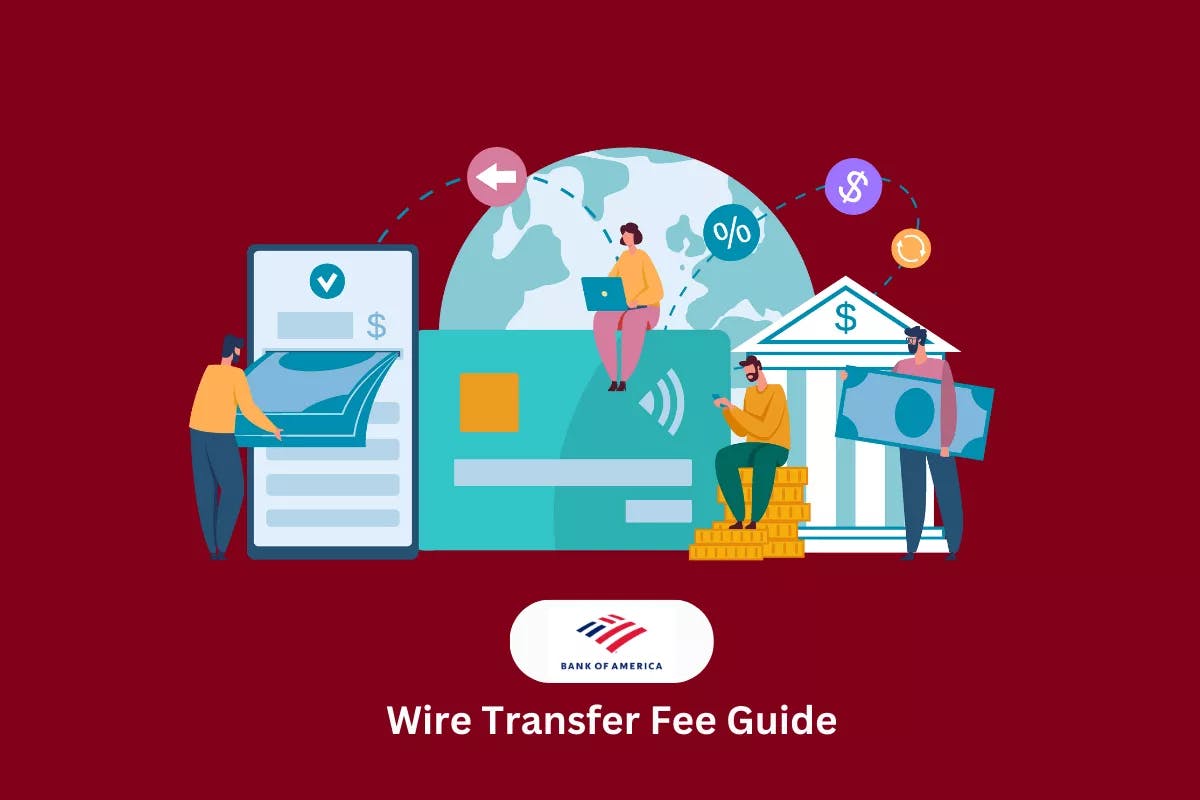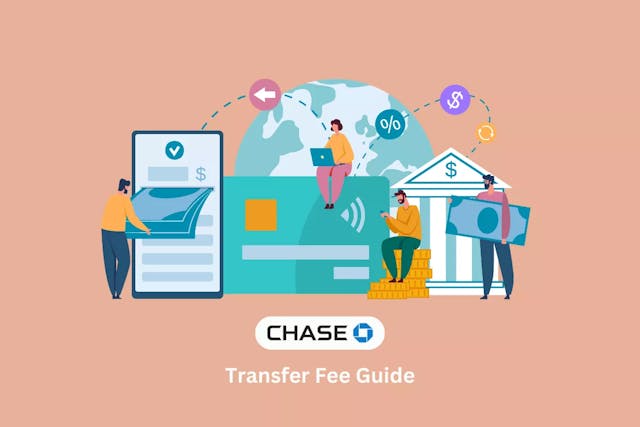Sending money via Bank of America (BoA) wire transfer will cost you $30 for domestic transfers and $45 for international transfers (sent in USD). However, if you convert your USD to the currency used by the country you’re transferring the money to, then BoA will waive the international wire transfer fee.
In the past, you could only initiate Bank of America wire transfers through BoA Online Banking or by setting an appointment with a local branch. But it’s now possible to make Domestic and International Wire Transfers through Bank of America’s mobile app.
Bank of America Wire Transfer Fees
Bank of America’s wire transfer fees vary depending on whether you’re making a domestic wire transfer or an international wire transfer.
BoA doesn’t charge any fees for international wire transfers sent in foreign currency.
| Type of Wire Transfer | BoA Transfer Fee |
| Domestic Wire Transfer | $30 |
| International Wire Transfer (U.S. Dollar) | $45 |
| International Wire Transfer (Foreign Currency) | $0 |
💡 Note: Fees for outgoing international wire transfers in U.S. dollars cost more due to the funds being converted into foreign currency.
In addition, International Wire Transfers to the following countries should be sent in USD: Colombia, Nigeria, Palestine, Panama, Somalia, Timor-Leste, and Venezuela.
What’s the Transaction Limit for BoA Wire Transfers?
The transaction limit for each Bank of America wire transfer depends on whether the customer is a small business or just a regular consumer.
- Consumer Transaction Limit: $1000
- Small Business Transaction Limit: $5000
What is a Wire Transfer?
A wire transfer, sometimes called a bank transfer or credit transfer, is a way to move funds from one bank account to another electronically.
Wire transfers take place using secure financial transfer services between banks and SWIFT, the Federal Reserve Wire Network, or the Clearing House Interbank Payments System.
Banks, including Bank of America, send money overseas through the SWIFT system. SWIFT is a formalized messaging system that is essentially an international communication network of banks.
When you order an international wire transfer, your bank alerts the network and your payment travels through the system. Depending on how far your money has to go, or if a bank doesn’t have a corresponding account, the money bounces from bank to bank (known as intermediaries) until it finds a link with its intended destination.
What Is a Remittance Transfer?
A remittance transfer is a certain type of international wire transfer made by a Bank of America customer to someone in a foreign country for personal, family, or household purposes.
The main difference between a remittance transfer and a regular wire transfer is that you can cancel a remittance transfer within 30 minutes of submission to receive a full refund (fees included).
How Do I Cancel a BoA Remittance Transfer?
To cancel a Bank of America remittance transfer, just follow these steps:
- Log in to the BoA Mobile Banking App or Online Banking
- Select Pay & Transfer
- Locate the Transaction you want to cancel
- Select Cancel under Activity
- Review the Cancellation Notification
- Select Cancel again
💡 Note: You can also cancel a BoA Remittance transfer by calling 1-877-337-8357.
What Do You Need to Send a Wire Transfer?
The requirements for a wire transfer through Bank of America depend on whether you’re making a domestic or international transfer. However, if you choose to enroll in secure transfer, you’re going to need to prepare the following:
- Debit Card Number
- PIN
- U.S. mobile number or a USB security key
Domestic Wire Transfer Requirements:
- Recipient’s Name
- Recipient’s Address
- ABA Routing Number for Wires
- Account Number
International Wire Transfer Requirements:
- Recipient’s Name,
- Recipient’s Address
- SWIFT Code
- Account Number
- Specific Bank Identifiers or Account Identifiers (IBAN)
💡 Note: The cut-off time for wire transfers is 5 p.m. Eastern.
Does Bank of America have an IBAN?
IBAN stands for International Bank Account Number. It is the standard for how financial institutions identify bank accounts internationally. The U.S. does not participate in IBAN, therefore Bank of America does not have an IBAN.
However, when making an international money transfer to a bank account outside of the U.S., Bank of America recommends including the IBAN of participating countries when you make a wire transfer request.
To obtain an IBAN from an international, recipient bank, contact the bank directly.
How to Send a BoA Wire Transfer using the Mobile App
To initiate a domestic or international wire transfer online using the BoA Mobile App, just follow these steps:
- Open the BoA Mobile App
- Go to Pay & Transfer
- Tap Wire then Start a Wire
- Tap Add New Recipient (skip to step 8 if the recipient has already been added)
- Select the Country where the recipient’s account is located
- Complete the Required Fields
- Tap Add
- Choose Your Recipient and follow the onscreen steps

How to Receive a Wire Transfer Through Bank of America
Someone can wire you money domestically or internationally if they have:
- Your account number
- Your wire transfer routing number
- SWIFT Code (for incoming international transfers)
A SWIFT Code is a unique identification code that some banks require to complete secure international wire transfers. Bank of America requires a SWIFT code from international wire senders. SWIFT stands for Society for Worldwide Interbank Financial Telecommunication.
How Long Do Wire Transfers Take?
If you are transferring the money from your account, you can expect the debit to hit your account on the day of the transfer since Bank of America sends the funds immediately.
The recipient bank should receive the money within 1–2 days, and the wire transfer recipient can expect access to the funds within 2 days.
💡Note: Some factors may delay the wire transfer process, such as local holidays or delays. You may also experience delays if you’re sending money to a country that has been designated as a slow-to-pay country.
Related Fees
There may be a foreign transaction charge involved in international wire transfers through Bank of America. Your bank (the sender of the wire transfer) may automatically charge you a fee to convert your money to foreign currency.
If your bank does not automatically convert your money, the foreign bank can impose an interbank or mid-market exchange rate, which you would be forced to pay for as well.
Special Considerations
Depending on the type of Bank of America account that you have, the institution may waive your fee on certain types of wire transfers. Accounts that qualify for a fee waiver on incoming domestic wire transfers include:
- Bank of America Advantage Relationship Banking
- Bank of America Advantage with Tiered Interest Checking
- Bank of America Advantage Regular Checking accounts
- Bank of America Preferred Rewards Customers
Bank of America will also waive the fee for incoming international wire transfers for Preferred Rewards customers who are part of the Platinum and Honor tiers only.
How to Avoid a Wire Transfer Fee
Explore free options first
Before doling out money to transfer funds from here to there, you should do some research to find another option that won’t burn a hole in your wallet.
Digital payment companies, such as Zelle and Venmo, enable you to send and receive money in real time and free of charge.
When using an online banking option, you should still check with Bank of America that you are not on the hook for additional charges.
Research fees and select the best option
If you decide that you need to send money via wire transfer, it can pay off to find a bank that charges the least amount in fees for such transfers. Some banks have absolutely no fees, while other banks have minimal fees.
For instance, Fidelity offers free outgoing and incoming domestic and international wire transfers completed in U.S. dollars.
How to Get a Wire Transfer Fee Refund
It can be challenging to successfully negotiate a wire transfer fee refund with Bank of America, but it’s not a lost cause. There are a couple of things that you can do to increase your chances of success. Note that these suggestions apply for negotiating Bank of America fees if you send an international wire transfer but may not apply to fees imposed by the foreign financial institution.
Properly prepare for your negotiation
Have all personal information ready when you contact Bank of America customer service, including your name, account number, when you completed the transfer and any other necessary information that will help you feel prepared.
Introduce yourself
Start with: “Hello. My name is , and I recently received a wire transfer fee. I’m contacting you to see if you would be willing to issue me a refund.”
Note your points of leverage
Are you facing financial hardship as a result of COVID-19? Is this your first time requesting a wire transfer fee refund from Bank of America? Do you not send wire transfers frequently?
Be patient, persistent, and prepared not to get a refund
Remember that the customer service representative that you are speaking with likely didn’t write the rules on bankfee refunds. No matter how the conversation is going, be calm and polite to the representative. In these situations, a little kindness can go a long way toward helping you achieve your goal — in this case, getting a refund.
You can be kind but also be persistent. The representative will likely tell you that they can not issue you a refund right off the bat. That is okay and highly likely. At this point, you can present whatever points of leverage that you’ve prepared to try to get the representative to see things from your point of view. If you’re not able to make progress with one customer service representative, you can always ask to speak with a supervisor, or call back at a later date to speak with someone new.
Finally, you should go into the conversation knowing that not every negotiation will end positively for you. In fact, the more often that you incur and attempt to negotiate fees, the less likely that your bank might be to negotiate them. If you do not win one negotiation, try to remain positive and focus on avoiding fees in the future.
Find Bank of America’s full fee schedule here.



